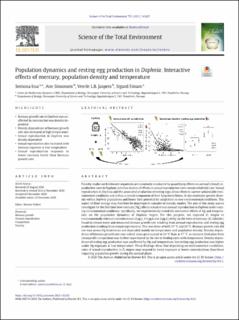| dc.contributor.author | Issa, Semona | |
| dc.contributor.author | Simonsen, Ane | |
| dc.contributor.author | Jaspers, Veerle | |
| dc.contributor.author | Einum, Sigurd | |
| dc.date.accessioned | 2021-03-05T11:17:57Z | |
| dc.date.available | 2021-03-05T11:17:57Z | |
| dc.date.created | 2021-01-07T15:57:00Z | |
| dc.date.issued | 2021 | |
| dc.identifier.issn | 0048-9697 | |
| dc.identifier.uri | https://hdl.handle.net/11250/2731827 | |
| dc.description.abstract | Toxicity studies on freshwater organisms are commonly conducted by quantifying effects on asexual (clonal) reproductive rates in Daphnia, whereas studies of effects on sexual reproductive rates remain relatively rare. Sexual reproduction in Daphnia and the associated production of resting eggs allows them to survive unfavorable environmental conditions and is thus a crucial component of their long-term fitness. It also maintains genetic diversity within Daphnia populations and hence their potential for adaptation to new environmental conditions. This aspect of their biology may therefore be important to consider in toxicity studies. The aim of this study was to investigate for the first time how mercury (Hg) affects sexual versus asexual reproduction in Daphnia under varying environmental conditions. Specifically, we experimentally tested the interactive effects of Hg and temperature on the population dynamics of Daphnia magna. For this purpose, we exposed D. magna to environmentally relevant concentrations (0 μg/L, 0.5 μg/L and 2 μg/L) of Hg (in the form of mercury (II) chloride) found in stream water and measured biomass growth rate resulting from asexual reproduction, and resting egg production resulting from sexual reproduction. This was done at both 17 °C and 24 °C. Biomass growth rate did not vary across Hg treatments and depended mainly on temperature and population density. Density dependence of biomass growth rate was indeed more pronounced at 24 °C than at 17 °C, as resource limitation from intraspecific competition was further exacerbated by the rise in feeding rates with temperature. Density dependence of resting egg production was unaffected by Hg and temperature, but resting egg production was higher under Hg exposure at low temperature. These findings show that depending on environmental conditions, rates of sexual reproduction in D. magna may respond to metal exposure at lower concentrations than those impacting population growth during the asexual phase. | en_US |
| dc.language.iso | eng | en_US |
| dc.publisher | Elsevier | en_US |
| dc.rights | Attribution-NonCommercial-NoDerivatives 4.0 Internasjonal | * |
| dc.rights.uri | http://creativecommons.org/licenses/by-nc-nd/4.0/deed.no | * |
| dc.title | Population dynamics and resting egg production in Daphnia: Interactive effects of mercury, population density and temperature | en_US |
| dc.type | Peer reviewed | en_US |
| dc.type | Journal article | en_US |
| dc.description.version | publishedVersion | en_US |
| dc.source.journal | Science of the Total Environment | en_US |
| dc.identifier.doi | 10.1016/j.scitotenv.2020.143625 | |
| dc.identifier.cristin | 1867264 | |
| cristin.ispublished | true | |
| cristin.fulltext | original | |
| cristin.qualitycode | 2 | |

